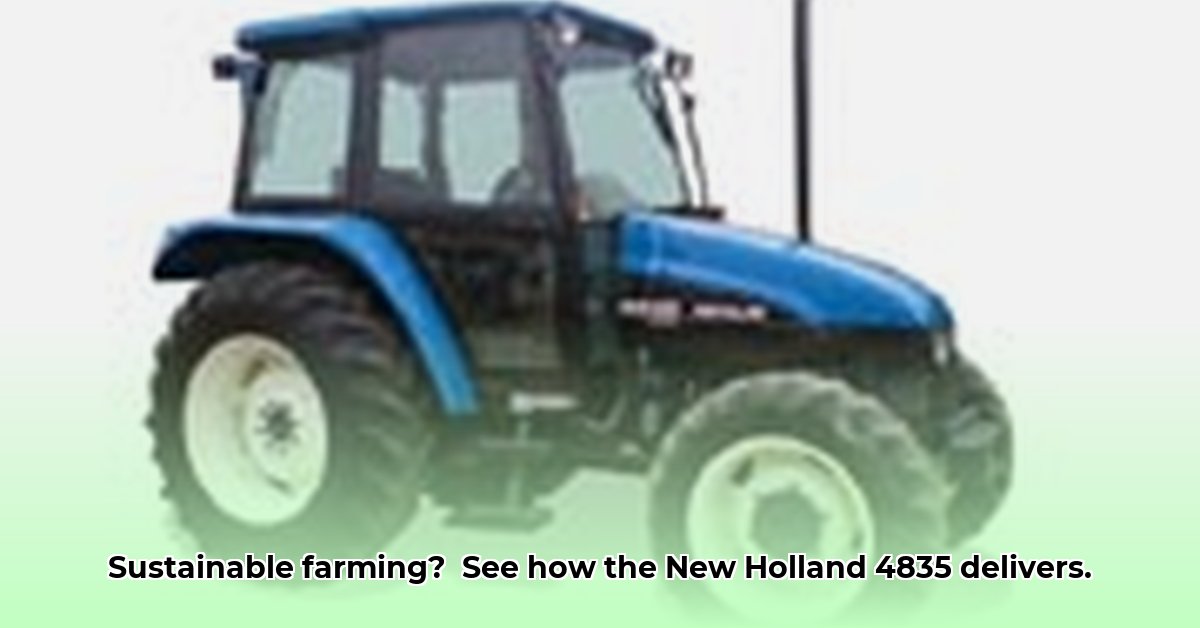
The New Holland 4835 tractor, a mainstay on farms throughout the late 1990s, offers a compelling case study in the evolution of sustainable agriculture. This review examines its capabilities, historical context, and its alignment with modern environmentally conscious farming practices. We'll analyze its strengths and limitations, ultimately assessing its suitability for today's agricultural landscape. For more information on smaller New Holland tractors, check out this helpful resource.
Power and Purpose: Understanding the 4835's Capabilities
The New Holland 4835 boasted a horsepower range of 60-75, substantial for its era, powering tasks from plowing to hauling. Its 29-gallon fuel tank provided decent range, minimizing refueling stops. The 56-horsepower PTO (power takeoff, the tractor's power source for external implements) was a key feature for tasks like haying. Weighing between 5,954 and 7,056 pounds, it was a robust machine designed for demanding farm work. Its versatility contributed to its widespread popularity. But how does this translate to contemporary sustainable agriculture? Isn't it true that power comes at a cost, especially in terms of fuel efficiency and emissions?
Farming in the 1990s: A Technological Crossroads
Understanding the 4835 requires acknowledging the agricultural context of the late 1990s. Larger farms and increased efficiency were driving forces, but sustainability was a nascent concept. The focus was on maximizing yield, with less emphasis on minimizing environmental impact. The 4835, a product of this era, reflects these priorities. It was a powerful, reliable machine optimized for productivity with the technology then available. However, its design predates the widespread adoption of precision agriculture techniques that are now considered essential for sustainable farming.
Sustainability Assessment: Bridging the Data Gap
Assessing the 4835's sustainability is challenging due to a lack of readily available data on fuel efficiency and emissions. This absence of critical information limits our ability to definitively assess its environmental impact compared to more modern tractors. Modern farming emphasizes minimizing fuel consumption and greenhouse gas emissions. While the 4835 was dependable, its performance against current fuel-efficient models remains unclear. The absence of features like GPS guidance or advanced sensors, now commonplace, further underscores the technological advancements of recent years. How can we effectively evaluate its sustainability without comprehensive data?
Actionable Insights: A Multi-Stakeholder Approach
To fill the data gap, further research comparing older and newer equipment is necessary. This research should encompass lifecycle costs and environmental impact, enabling informed decisions about farm equipment. This involves a collaborative effort among various stakeholders:
- Farmers: Evaluate operational costs (fuel, maintenance) of older tractors against modern, fuel-efficient models. Consider upgrading to more sustainable equipment and implementing precision agriculture.
- Dealers/Manufacturers: Provide detailed comparisons of older and newer models, highlighting fuel economy, emissions, and long-term costs. Develop trade-in and upgrade programs to facilitate a transition to more sustainable options. Invest heavily in R&D for sustainable technologies.
- Policymakers: Implement incentives for upgrading to fuel-efficient tractors and stricter emissions regulations. Support research into sustainable agricultural practices, fostering innovation.
- Researchers: Conduct lifecycle assessments of various tractor models, examining fuel consumption, emissions, and overall environmental impact. Develop methods to retrofit older tractors with improved technologies.
These actions can collectively improve both sustainability and the bottom line. How can we best encourage these collaborations to drive impactful change?
Conclusion: The Legacy of the New Holland 4835
The New Holland 4835 serves as a potent reminder of the importance of data-driven decision-making in sustainable agriculture. Its reliability is undeniable, but a complete environmental impact assessment is hampered by a lack of readily available data. This underscores the crucial need for detailed, standardized data collection on fuel consumption, emissions, and the overall environmental footprint of agricultural machinery. Only with this information can informed decisions be made about future equipment investments. The 4835's legacy highlights the urgent need to prioritize sustainability alongside functionality and reliability in modern agriculture. How can we ensure that future agricultural innovations prioritize both efficiency and environmental stewardship?